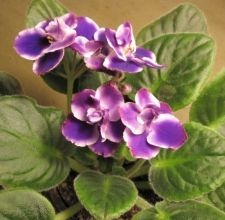A healthy African violet is easy to recognize. It has well-formed leaves, a strong root system, and frequent blossoms. It is free of rot; mildew; mold; fungus; holes in foliage or in blossoms; and of water-logged stems or leaves. Insect and pest damage is difficult to successfully treat, so prevention is key. This article presents some simple but effective methods to protect an African violet from becoming damaged by insects and/or pests.
- Difficulty:
- Moderately Easy
Instructions
things you’ll need:
- African violet
- Watering can with narrow spout
- Absorbent paper towel
- Bleach
- Water
- Soap
- Six feet of horizontal space away from other African violets or houseplants OR Separate room
- Sterilized African violet potting soil
 Use a watering can with a narrow spout.
Use a watering can with a narrow spout.
Keep dry the leaves of your African violet to prevent powdery mildew and crown rot.
If you water your plant from the top, use a watering can with a narrow spout so that it can reach underneath the leaves to water the soil.
If a drop-or more-of water lands on a leaf, touch the edge of an absorbent paper towel to the drop to draw it off of the leaf. Do not return the African violet to its brightly-lit place by a window until the leaf is totally dry, or the leaf can be permanently marked.- Do not allow the African violet to sit in water collected in the saucer.
Always return to the African violet no later than 30 minutes after watering it and empty the saucer of any excess water so that root rot or crown rot will not develop.
Do not over water. See "How to Water an African Violet" for more information. - Always isolate a new plant from the others for a good 6 to 8 weeks to see if any damage develops which would indicate the presence of insects or pests.
It’s best to put the new plant in a separate room during this time. If that’s not possible, space the new plant at least six feet away from any others. Be sure that the new African violet is situated optimally for light, warmth and humidity. See "How to Provide Light for an African Violet."
 Immediately wash your hands after tending a new plant.
Immediately wash your hands after tending a new plant.
Thoroughly wash your hands after you have tended the new, isolated plant, to avoid spreading pests to your healthy African violets. Some also cover their clothing before entering the room of the exiled plant so that any mold spores will not transfer to and be carried out of the room by their clothes.
 1:15 = bleach: water
1:15 = bleach: water
Routinely wash all saucers, implements, and empty pots; sterilize with a 15 minute soak in a bleach solution (1 part bleach in 15 parts water); and rinse with clean water. A dedicated watering can and other implements should be kept in the separation room.
- When you re-pot or transplant an African violet, use only sterilized African violet potting soil. Never mix in garden soil!
 Doctor Optimara: Diagnosing an African Violet
Doctor Optimara: Diagnosing an African Violet
Each time you water an African violet, inspect the plant for any signs of insect or pest damage. Optimara.com has an excellent online tool for diagnosis and treatment of various African violet illnesses, and the link is included under Resources.
Tips & Warnings
-
Avoiding insects and pests is much easier than removing an infestation and treating the condition.
-
Some insects can be removed with a soapy water bath or spray; or by removing individual pests with a cotton-tipped swab saturated with alcohol.
-
If an African violet is thoroughly infested, you may be able to salvage a leaf for propagation. After removing the leaf, soak it in the bleach solution for 15 minutes before proceeding. See "How to Rejuvenate an African Violet by Repotting."
-
Do not ignore signs or symptoms of insect and pest infestation. These problems only become worse when treatment is delayed.


Deprecated: strpos(): Passing null to parameter #1 ($haystack) of type string is deprecated in /home/agriviek8Qv/agriviet.net/public_html/wp-includes/comment-template.php on line 2522